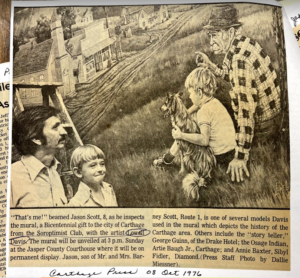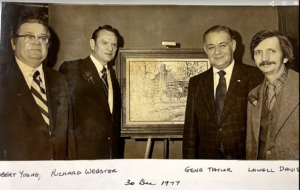Dedicated during the nation’s bicentennial celebration, Lowell Davis’ sweeping mural “Forged in Fire,” on the south wall of the east wing of the main floor of the Jasper County Courthouse, has wowed visitors and school children more than four decades.
Push the button under the mural; a courthouse visitor can listen for about four minutes as Ron Peterson Senior’s booming baritone radio voice describes the scenes from left to right as they tell the history of Jasper County and Carthage in vivid colors and detail.
Auctioneer and former Presiding Jasper County Commissioner Danny Hensley said this mural was one of Lowell Davis’ most significant contributions to Davis’ hometown. Hensley used to give tours of the Courthouse to thousands of school children a year, and the mural was always a highlight of the tour. “I think anyone who goes through Carthage and takes a tour of the town if they don’t come up and see this mural, they’ve missed a lot,” Hensley said. “It’s just a really neat history starting back with the Indians and coming on forward. It tells the story of Carthage and Jasper County. I’m just really proud of it.”
Davis was proud of the mural too. He used to come to the Courthouse to see friends and conduct business, and he’d pause by his creation and look it over and talk about it to anyone who happened to be around. Some recognized him as the mural’s creator, and others didn’t, but he was willing to talk to all of them when he was there.
Lowell Davis passed away on Nov. 2, 2020, at the age of 83, at his home in the community he created northeast of Carthage called Red Oak II and is buried in the whimsical cemetery in a plot he designed himself.
About the mural
The “Forged in Fire” mural was dedicated as “a Bicentennial Gift to the City of Carthage from the Soroptimists International of Carthage” on Oct. 10, 1976. It was a year of celebration to commemorate 200 years after the Declaration of Independence was signed on July 4, 1776.
A 24-page booklet printed as a program for that mural dedication said the artist, Lowell Davis had an idea for a mural in the Jasper County Courthouse in the 1950s as a 19-year-old Carthage native returning from service in the United States Air Force.
An article in the program by Carthage Press reporter Neil Campbell said Davis made drawings of a proposed mural back in the 1950s. He was to rediscover those drawings in 1976 when the Soroptimists first approached him about the project.
“It would be the group’s bicentennial contribution to the city, and they wondered if Davis might be interested,” Campbell wrote in the article. “The club had also been ‘kicking around’ the idea of a mural for several years. Only then did the organization’s idea and the artist’s dream begin to merge. A crash program of research followed, using The Press files as primary source material. Care was taken that ‘every face, every building, every tombstone was faithfully rendered.”

A photo in The Carthage Press from Oct. 8, 1976, shows Davis inspecting the mural with a young boy, Jason Scott, then 8, who served as the model for the young boy and his dog listening to an older storyteller in the lower right corner of the mural.
The caption of the photo says George Guinn, then living in the Drake Hotel, served as the model for the storyteller and names Artie Baugh Jr., as the model for the Osage Indian and Sibyl Fielder, Diamond, as the model for Annie Baxter on the left side of the mural.
The Oct. 10, 1976 dedication of the mural, according to the booklet, was headlined by then Missouri First Lady Carolyn Bond and featured local political figures of the time, State Rep. Robert Ellis Young, State Sen. Richard Webster, and U.S. Congressman Gene Taylor in various roles.

Ruth Evans, then president of the Soroptimist International of Carthage, read the welcome; Presiding Jasper County Judge Byron Fly led the Pledge of Allegiance; Carthage’s Ida Ruth “Platt” Locarni, described as a mezzo-soprano in the program and accompanied by Frances Pierce, sang “This Is Our Country” and Let There Be Peace on Earth;” Dallie Miessner, the Chair of the Mural Committee, introduced Davis; Harriette Murray, the 1975 president of the Soroptimists, presented the mural; and then-Mayor Byron C. Hallam accepted it.
Campbell’s article said the mural became an “around-the-clock endeavor” and said Davis suspended all his other work to devote full time to the project.
“A mural is to the artist, at least to this artist, as Carnegie Hall is to the musician,” Davis said in the article. “I truly believe this is the ultimate challenge.”
Other works and honors
On June 8, 1937, Davis was born in Lawrence County to Berton Clayton Davis and Nell Marie Davis; Lowell Davis grew up in Red Oak, MO, near the Lawrence-Jasper County line and moved to Carthage during his elementary school years.
He married Rose Castillo Davis in 2003 and has three daughters and three sons from previous marriages: April Davis Brunner, also an artist, Heather Davis, Wren Davis, Phillip Davis, Jeb Davis, and Aaron Davis.
He attended Mark Twain School and Carthage High School.
Davis described his time at Mark Twain school in an interview in September 2017 when the school celebrated its 100th birthday.
“I came from a country school,” Lowell Davis said. “I was in the fifth grade, and I went to Mark Twain when we moved to Carthage. The painting I did for the school’s 75th birthday, that’s me outside the school with a bicycle, and homemade clothes, and a $5 bicycle, and I’m looking at the school. It’s just so big compared to the country schools I was used to going to. There was a teacher here; she noticed my talent. It was Mrs. Esterle, she gave art lessons here, and she paid my way to taking art lessons for three years, so I dedicated that painting in there to her.”
Lowell Davis created a sculpture for Mark Twain School’s 100th birthday that still stands near the Main Street entrance to the school.
Davis served as an airman in the U.S. Air Force, then made a name as a commercial artist while living in Texas in the 1950s and 1960s.
A short Carthage Press article from Jan. 10, 1969, which may have been the first written about Davis, said he was “gaining considerable nationwide attention for his paintings.”
In 1974 he moved back to Carthage, Missouri, bought Fox Fire Farm northeast of Carthage, and in 1987 started buying homes and buildings from his hometown, Red Oak, Mo., and created Red Oak II, a small community on a loop around a tiny lake.
“I don’t believe that an artist should be restricted to use only paint of clay,” Davis wrote on the Red Oak II website, “It can be anything including junk, wood, even an old building. To me, Red Oak II is a combination of a painting and a sculpture, and it is just made from things that someone else threw away.”
In his final years, Davis created dozens of sculptures at businesses and other institutions around Carthage.
In 2016, when talking about one of those sculptures he created at the Jasper County Road Barn on the corner of North River Street and Missouri Highway 96, Davis said he couldn’t paint anymore because of arthritis. Still, the sculptures “got his adrenaline pumping again.”
His 3-D art with colorful names is scattered across Carthage, including “the Crapduster,” a whimsical biplane in front of the Flying W. Convenience Store at Highway 96 and County Route V; the piece called “Ain’t No Wonder His Wife Left Him,” at Jackson Tire, 614 E. Central, featuring an antique car and a steel image of a woman changing the tire while the man sits in the car; or the work called “Bad Hair Day,” in front of the Elite Hair Designs salon at 109 S. McGregor Ave.
Lowell Davis said he hoped his 3-D creations would be one more thing to put Carthage, Missouri on the map.
“They’re a lot of fun to make,” Davis said. “I was here when they put it up there. My son is really strong, so he can get the steel up there. When I was born, I had the choice of being good-looking or strong, and that day, I wish I had picked strong.”
In 2019, the community recognized Davis with two big honors: he was named Artist of the Year at the Carthage Chamber of Commerce Annual Banquet in January 2019, and he was named to the Hall of Carthage Heroes, and a plaque with his biography was placed on the wall at the Fair Acres Family Y in November 2019.

Another honor came his way when he became part of a huge new mural, created by one of his students, Andy Thomas, on the east wall of the McBride Building on the southeast corner of the Carthage Square.
Thomas said he got to show Davis his image that would be included in the mural before Davis died.
